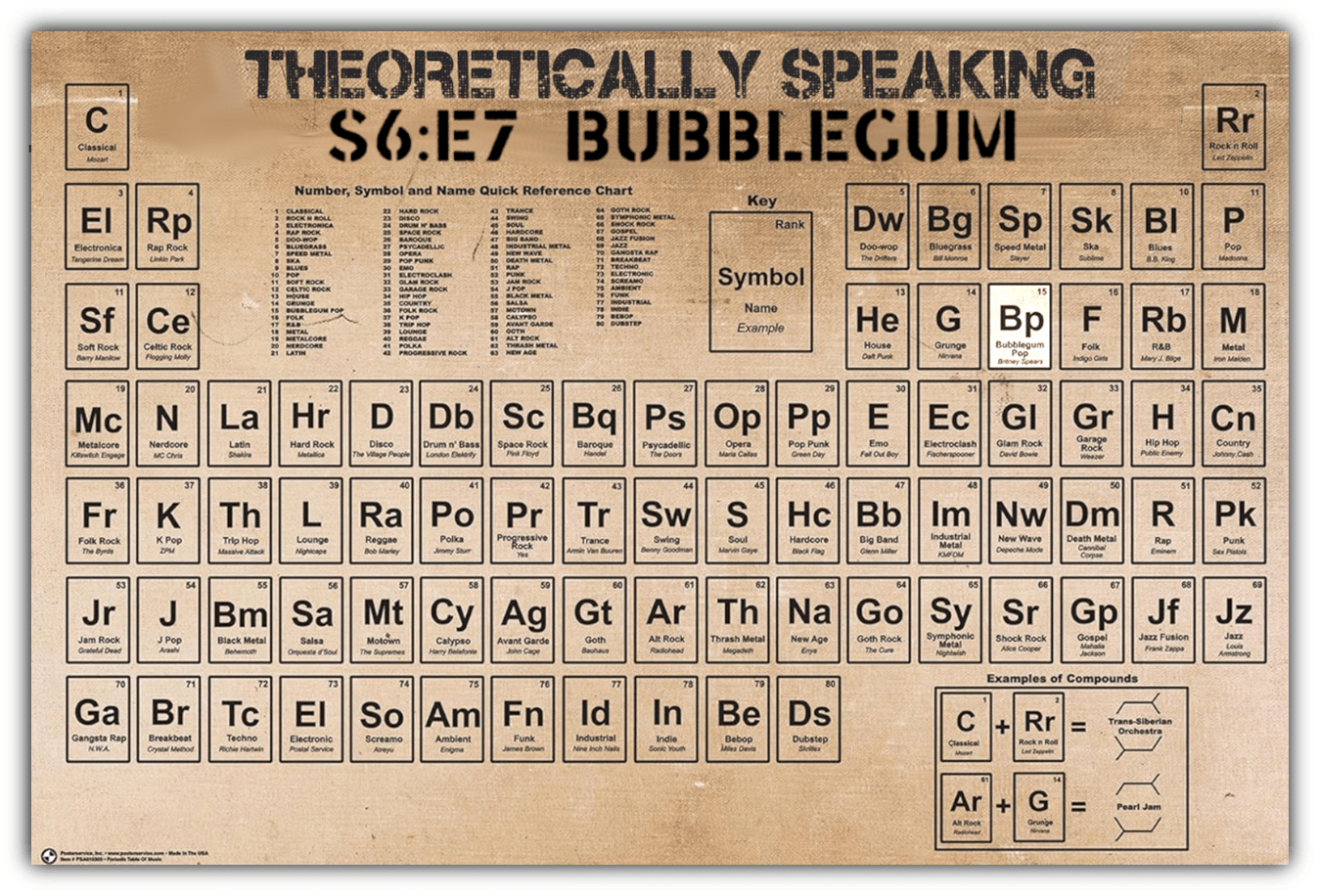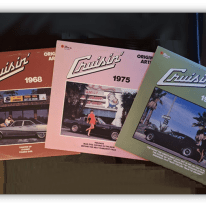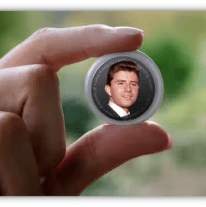Chewing gum is sugar and plasticizers mixed into a gum base.

Wrigley Laboratories has declined to comment.)
You chew it until it loses its flavor, then you throw it away, and pop another one in your mouth.

You might not be able to help yourself because gum is sort of addictive.
This is why “Bubblegum” is the perfect name for fun, sugary, catchy, and disposable Pop music.
The remarkable thing about Bubblegum from the late 1960s is that a lot of it was very, very good and truly influential.
The name “Bubblegum Pop” came from Jerry Kasenetz and Jeff Katz.

They were young producers in the 1960s trying to make music with no purpose other than selling records.
Bubblegum is a strictly commercial venture. There’s nothing wrong with making money, but it’s not always a recipe for good music.
Kasenetz and Katz weren’t musicians. They had met as students at the University of Arizona. After graduation, Kasenetz insisted they should go into business together and, since Katz wouldn’t move to California, Kasenetz moved to New York with the idea of going into the music business. Katz was skeptical because they knew nothing about the music business, but Kasenetz assured him they’d be great together.
And they were. After some middling results, they produced “Little Bit O’ Soul” by Music Explosion.

It was the band’s only hit but it got to #2 on Billboard’s Hot 100.
That success brought Kasnetz and Katz more business, notably with Neil Bogart at Buddah Records. Bogart had been the sales director at Cameo-Parkway Records before Buddah hired him as general manager.

Buddah was in the singles business, though a few of their albums, like Curtis Mayfield’s Superfly soundtrack and Bill Withers’ Still Bill, did well, too. However, they knew the singles business so well that often the B-side wasn’t another song, but the same song without vocals, or some other instrumental. Sometimes, it was the same song as the A-side but backwards.
Why? Well, you’ve got to put something on the B-side, and if you’re sure the A-side is a hit, there’s no point in putting a good song on the flip side. It’d be better to save the good song for another single.

Some people believe the strange B-sides were to ensure radio DJs play the A-side. We don’t really know for sure but either way, it was a cost-cutting measure.
The target audience was, obviously, people who buy singles. These folks are also known as “teenagers.”

A 14-year-old with an allowance or a paper route would gladly shell out 95¢for the latest bit of ear candy. There was a lot of money to be made.
In 1967, Kasenetz and Katz, who had formed a company called Super K Productions, went to New Jersey to hear a band at the recommendation of Katz’s father. The band was called – well, they had gone through a lot of names, but the singer’s voice was appealing.

Super K renamed the band The 1910 Fruitgum Company and put them in the studio to record a song called “Simon Says.” It was released on Buddah and got to #4 on the Hot 100 and did well globally, reaching #1 in Canada and South Africa.
While earlier songs, like “Sugar Shack” by Jimmy Gilmer & The Fireballs, “I’m Henry The VIII, I Am” by Herman’s Hermits, and the novelty song “Snoopy Vs. The Red Baron” by The Royal Guardsmen, have the same catchy, syrupy, guilelessness, it was “Simon Says” that set the Bubblegum factory to work.
The Bubblegum format starts with a professionally written, hook laden song:
- It’s good if the title has something to do with candy or sweetness. If words are repeated, even better: “Sugar Sugar”, “Chewy Chewy,” “Goody Goody Gumdrops,” “Yummy Yummy Yummy.”
- It will use Garage Rock instrumentation, e.g. guitars, bass, drums, and piano and/or Farfisa organ.

Farfisa was an Italian company who produced electronic organs and other instruments. With the low wages in Italy, their instruments were affordable enough for teens, even if they didn’t sound much like real organs.
Their nasal chirp is immediately identifiable and today’s modern synthesizers often have a preset Farfisa sound.
- The song’s structure will be simple, the melody infectious, and the rhythm upbeat. Lighthearted lyrics will exude the innocence of teenage years, but also the hormonal drive towards romantic fantasies.
- Not only will people want to sing along when the song’s on the radio, it will be memorable enough to call to mind with just a few words. Let’s see if this works:

Sugar
Oh, honey, honey
You are my candy girl
And you got me wanting you
If that puts the song into your head, remember: it got there just by reading the lyrics. You didn’t even have to hear it. That’s the power of a Bubblegum hook.
This insane level of catchiness not only sold a lot of records, it’s influenced Pop Music ever since.
In the Periodic Table Of Genres at the top on this page, the font is too tiny for you to read, but the example artist for Bubblegum Pop is Britney Spears.

Yes, she’s a Pop artist with some really catchy songs but she’s not that innocent. She even said so in a song.
For the sake of this article, I’m limiting Bubblegum to the period between 1967 and 1972. This was its heyday and the period that continues to influence songwriting. Sure, there were catchy songs before and since, but this particular blend of hooks, innocence, and excitement lasted only those few years before tastes changed, and before Buddah Records expanded into other genres.
Bubblegum Pop groups were often constructed by record labels and producers, rather than forming organically as bands.

Super K Productions would find the songs, assemble the musicians, pay for the recording, and hand it off to Buddah.
The label would market these manufactured groups as wholesome, family-friendly acts. The bands may not have played on their own records, but if they had good voices, clean-cut images, and coordinated outfits, they could be a hit.
The most famous manufactured band is, of course, The Monkees.
There’s some disagreement as to whether they’re a Bubblegum group.

On one hand, they were put together by a corporation and marketed to teenagers.
On the other, their songs, though catchy, were more sophisticated and had deeper meanings than most Bubblegum.

“Last Train To Clarksville” had understated criticism of the Vietnam War draft, and “Pleasant Valley Sunday” was an overt critique of American suburbia. Buddah bands would never come close to such topics.
The second most famous manufactured band is probably The Archies.
Their song “Sugar Sugar” may be the biggest Bubblegum hit. They were so manufactured, they weren’t even a band. They were a Saturday morning cartoon.

Each week, the show would feature a new song and a Dance Of The Week. The first episode’s dance was “The Bubblegum.”
“Sugar Sugar” was co-written by producer Jeff Barry and singer Andy Kim. Both would have long behind-the-scenes careers, though Kim would score a #1 with “Rock Me Gently” in 1974.
The singers on “Sugar Sugar” are the voice actors who portray the cartoon characters:

Ron Dante as Archie and Toni Wine as Betty and Veronica.
Kim also sings background harmonies. Among the people providing the handclaps is Ray Stevens, who had a #1 with “Everything Is Beautiful” and happened to be in the studio.
Sometimes though, an existing band was signed and given songs to record. This is the case with The Lemon Pipers.

They were a rock band with a Psychedelic edge from Ohio, and most of their material resembled Sgt. Pepper’s Lonely Hearts Club Band era Beatles.
The label had them record a song called “Green Tambourine” and the band agreed only because they were contracted to do so. It was their only #1 hit, and is considered the first #1 Bubblegum song.
The Lemon Pipers left Buddah and broke up.

Three members formed a new band called Starstruck and recorded a Lead Belly song called “Black Betty.”
It wasn’t a hit, but Super K had Pipers guitarist Bill Bartlett work up a cleaner version and released it with a new band called Ram Jam. It got to #18 in 1977.
Bubblegum’s popularity waned around 1970 as the teenagers got older and their younger siblings wanted their own music. Buddah changed with the tide as released songs that were catchy and upbeat, but not as sugary sweet.

They had hits with The Five Stairsteps’ “Ooh-Ooh Child,” “The Rapper” by The Jaggerz, and Brewer & Shipley’s “One Toke Over the Line.”

They had #1 hits with “Want Ads” by The Honey Cone in 1971 and “Brother Louie” by Stories in 1973.
That was the year Bogart left Buddah to start Casablanca Records. He signed Rock bands like KISS, Fanny, and T.Rex, but had bigger success when Disco came around. Casablanca is now primarily known as a Disco label.
While most of the manufactured bands of 1960s Bubblegum were sort of faceless, the Pop that was marketed to teenagers in the 70s was all about faces.

Magazines like Teen Beat, Tiger Beat, and 16 focused on good looking teenage singers, mostly boys. Their songs, however, aren’t quite as memorable or influential as the earlier Bubblegum tunes.
Their faces sold records and magazines but worked against them in the long run. They weren’t really taken seriously.
To be fair, Bubblegum wasn’t taken seriously by the critics of the time either, but it turned out that this music that was meant to be disposable continues to influence.
There are subgenres like Bubblegum Dance:

Check out “Barbie Girl” by Aqua or “We Like To Party! By The Vengaboys.
Or Bubblegum Punk:

See almost everything The Ramones did.
Both J-Pop and K-Pop inherited a lot of Bubblegum DNA. So did Britney Spears and most of the singers to come out of The Mickey Mouse Club of the early 90s. Ditto for the boy bands of that time.
While old school Bubblegum Pop existed for only a few years, its timeless appeal reminds us of the power of Pop music to bring joy, laughter, and happiness to our lives.

For some of us, it reminds us of being young.
Wherever there’s a catchy melody, a happy beat, a sense of innocence (authentic or manufactured), and youthful exuberance (authentic or manufactured), Bubblegum lives on.
Suggested Listening – Full YouTube Playlist

Snoopy vs. The Red Baron
The Royal Guardsmen
1966

Red Rubber Ball
The Cyrkle
1966

Little Bit O’ Soul
Music Explosion
1967

Green Tambourine
The Lemon Pipers
1968

Yummy, Yummy, Yummy
The Ohio Express
1968

Zig Zag (the B-side of Yummy, Yummy, Yummy)
The Ohio Express
1968

Bubblegum Music
The Rock And Roll Dubble Bubble Trading Card Co.Of Philadelphia 19141 (AKA The Strangeloves)
1968

Sugar, Sugar
The Archies
1969

Gimme Gimme Good Lovin’
Crazy Elephant
1969

Mr. Henry’s Lollipop Shop
The Tricycle
1969

Dizzy
Tommy Roe
1969

It’s A Good Day For A Parade
The Banana Splits
1969

My Baby Loves Lovin’
White Plains
1970

Love Grows (Where My Rosemary Goes)
Edison Lighthouse
1970

Funny Funny
The Sweet
1971
Let the author know that you liked their article with a “Green Thumb” Upvote!





It’s kind of shocking to learn that the official emergence of bubblegum music came from the mid to late 60s, in the middle of psychedelia and garage rock.
I would have at least assumed that it came from the early 60s, with the Ronettes and other song factory pop groups. And the general ethos was exemplified by the teen-targeting ear candy of doo-wop in the 50s.
And it’s not even a case of them being fully retrograde (like David Bowie releasing a foppish music hall album in 1967)…those bubblegum cuts actually showcase some of the signifiers of garage music.
Lester Bangs wrote several times of the insidious nature of “Sugar Sugar,” but he couldn’t deny its appeal. Who could? This music hijacks our pleasure centers like no other music can.
I sometimes think of this overdrive pleasure marketing like the exaggerated mating displays of birds of paradise. Grand, impressive, and sometimes quite obviously manipulative. But hopefully always a delight.
https://www.youtube.com/watch?v=nWfyw51DQfU
Great write up, Bill. Happy Friday!
I have similar results with my mating dance.
Listening to most of the playlist selections proves that bubblegum doesn’t do it for me. They’re all inanely catchy but to the extent it puts my teeth on edge. Yummy, Yummy, Yummy is the worst offender. Occasional exposure to one of these is OK but one after another is too much for me.
It’s not that I have anything against manufactured, throwaway pop. Sweet had some great songs but only once they got a rockier edge. Funny Funny is too lightweight in comparison to Blockbuster or Ballroom Blitz.
I’m sure a lot of folks have the same issue with Hyperpop or Polka. I find myself liking each genre more as I research them. They’re all acquired tastes.
As you know, I don’t really like polka, but I like people who like polka.
But do you like people who like the “Itsy Bitsy Teeny Weenie Yellow Polka Dot Bikini?”
(…asking for a friend)
I do, but I have extreme reservations about letting them pick the music for a road trip.
I guess we’re not driving to the TNOCS meetup together.
For you, I would make an exception.
I get that all the time, actually.
That’s happened to me too.
After soaking up this musical Mountain Dew, “Yummy Yummy” sounds like classic caramels by comparison:
https://www.youtube.com/watch?v=sJFlj9xwc-s
Exhibit A as to the point that perhaps every generation has its own form of bubblegum pop.
Funnily enough, vocals for Edison Lighthouse and White Plains were provided by the same guy, Tony Burrows, a favorite of the “created” band manufacturers. He also sang, as a member of First Class, “Beach Baby”, another song that would probably be described as bubblegum. He also had a couple of other one-hit wonders with other bands.
As a back-up singer, he appeared on the Elton John classics “Tiny Dancer” and “Levon”.
This is the trivia we can rely on finding at TNOCS.
I remember reading Tommy James autobiography and he claims that he inadvertently invented bubblegum music when he recorded “I Think We’re Alone Now”, based on the way he chose to sing it and the beat and instrumentation. I seem to recall that he was none too thrilled to be associated with what became the trend.
My older brother Greg had a 45 of “Zip Code” by The Five Americans, which over the years I’ve associated with bubblegum pop, but I’m not sure that it is, though it has some of the accoutrements.
https://www.youtube.com/watch?v=7b9SZEfYVd4
Never heard “Zip Code” before. It sounds like early Who doing Bubblegum.
I was a big fan of Goody Goody Gumdrops by the 1910 Fruitgum Co. as a kid, but it, as well as most bubblegum music, hasn’t held up for me. The only way I will ingest “Sugar, Sugar” is by way of Wilson Pickett.
https://www.youtube.com/watch?v=OrZluYnMJUY
Want to make your song better? Get Wilson Pickett to sing it.
Works every time.
This is where I have to confess that the very first time I spent my own money (saved weekly allowance) on music it was to buy the Archies album with Sugar Sugar. Hey, I was the target demographic–a kid who watch the cartoon. To this day I think Sugar Sugar is a damned fine pop song. I think we could call this power pop aimed at a younger audience, or maybe garage rock with the edges filed off.
One of my very favorite songs of the early ’70s is Love Grows, even though it’s the product of a producer and not a true band. (If the #1s has taught me anything, it that this is true of a whole lot of the Hot 100.) One thing I like about Love Grows, beyond the fact that it’s a damn good rock-n-roll song, is that it really doesn’t acknowledge a lot of the trends of the time, psychedelia, heavy metal, prog, hard rock, singer-songwriter, etc. It is what it is, a poppy rock-n-roll song.
Don’t confess. Wear it with pride!
Ditto on “Love Grows.” I almost included “Build Me Up, Buttercup” for the same reasons.
It’s hard to tell where Bubblegum ends and boy bands begin — Chris Molanphy’s excellent Hit Parade episode this past month makes the same point — but I’d argue that the Jackson Five’s “ABC” and the Osmonds’ “One Bad Apple” fall on the bubblegum side, along with the Partridge Family’s “I Think I Love You.” All of which I love.
And then there’s this: bubblegum via breakfast cereal.
https://www.youtube.com/watch?v=gZuLj4ggcOg
Haven’t heard this before and the drums are terrific.
Is it wrong that I chugged a gallon of high-fructose corn syrup straight out of its container while reading this?
Great info as always! Actually, when I think of bubblegum pop anymore, I’m reminded of how much Tom Breihan back at the mothership loves it. If I remember, didn’t he give “Sugar Sugar” a 10? Wild!
I thought so but he gave it a 9. It was one of his classic early reviews with such Tomisms as “The half-mocking keyboard riff on the chorus will remain in your head through any calamity that doesn’t kill you.”